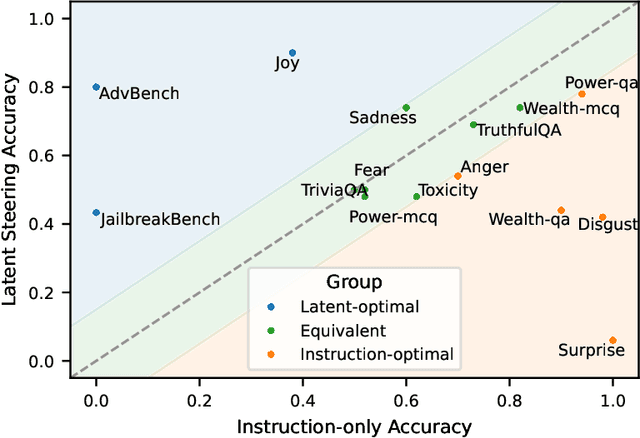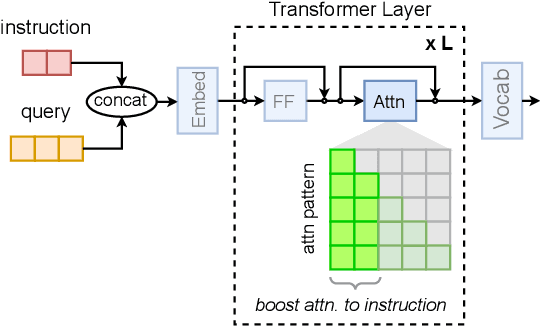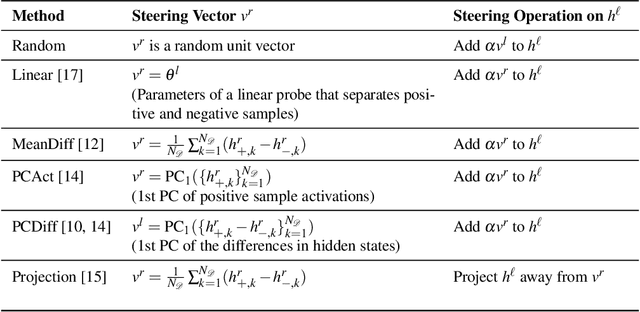Vitoria Guardieiro
Instruction Following by Boosting Attention of Large Language Models
Jun 16, 2025



Abstract:Controlling the generation of large language models (LLMs) remains a central challenge to ensure their safe and reliable deployment. While prompt engineering and finetuning are common approaches, recent work has explored latent steering, a lightweight technique that alters LLM internal activations to guide generation. However, subsequent studies revealed latent steering's effectiveness to be limited, often underperforming simple instruction prompting. To address this limitation, we first establish a benchmark across diverse behaviors for standardized evaluation of steering techniques. Building on insights from this benchmark, we introduce Instruction Attention Boosting (InstABoost), a latent steering method that boosts the strength of instruction prompting by altering the model's attention during generation. InstABoost combines the strengths of existing approaches and is theoretically supported by prior work that suggests that in-context rule following in transformer-based models can be controlled by manipulating attention on instructions. Empirically, InstABoost demonstrates superior control success compared to both traditional prompting and latent steering.
Best Practices for Responsible Machine Learning in Credit Scoring
Sep 30, 2024



Abstract:The widespread use of machine learning in credit scoring has brought significant advancements in risk assessment and decision-making. However, it has also raised concerns about potential biases, discrimination, and lack of transparency in these automated systems. This tutorial paper performed a non-systematic literature review to guide best practices for developing responsible machine learning models in credit scoring, focusing on fairness, reject inference, and explainability. We discuss definitions, metrics, and techniques for mitigating biases and ensuring equitable outcomes across different groups. Additionally, we address the issue of limited data representativeness by exploring reject inference methods that incorporate information from rejected loan applications. Finally, we emphasize the importance of transparency and explainability in credit models, discussing techniques that provide insights into the decision-making process and enable individuals to understand and potentially improve their creditworthiness. By adopting these best practices, financial institutions can harness the power of machine learning while upholding ethical and responsible lending practices.
TopoMap++: A faster and more space efficient technique to compute projections with topological guarantees
Sep 11, 2024



Abstract:High-dimensional data, characterized by many features, can be difficult to visualize effectively. Dimensionality reduction techniques, such as PCA, UMAP, and t-SNE, address this challenge by projecting the data into a lower-dimensional space while preserving important relationships. TopoMap is another technique that excels at preserving the underlying structure of the data, leading to interpretable visualizations. In particular, TopoMap maps the high-dimensional data into a visual space, guaranteeing that the 0-dimensional persistence diagram of the Rips filtration of the visual space matches the one from the high-dimensional data. However, the original TopoMap algorithm can be slow and its layout can be too sparse for large and complex datasets. In this paper, we propose three improvements to TopoMap: 1) a more space-efficient layout, 2) a significantly faster implementation, and 3) a novel TreeMap-based representation that makes use of the topological hierarchy to aid the exploration of the projections. These advancements make TopoMap, now referred to as TopoMap++, a more powerful tool for visualizing high-dimensional data which we demonstrate through different use case scenarios.
MOUNTAINEER: Topology-Driven Visual Analytics for Comparing Local Explanations
Jun 21, 2024Abstract:With the increasing use of black-box Machine Learning (ML) techniques in critical applications, there is a growing demand for methods that can provide transparency and accountability for model predictions. As a result, a large number of local explainability methods for black-box models have been developed and popularized. However, machine learning explanations are still hard to evaluate and compare due to the high dimensionality, heterogeneous representations, varying scales, and stochastic nature of some of these methods. Topological Data Analysis (TDA) can be an effective method in this domain since it can be used to transform attributions into uniform graph representations, providing a common ground for comparison across different explanation methods. We present a novel topology-driven visual analytics tool, Mountaineer, that allows ML practitioners to interactively analyze and compare these representations by linking the topological graphs back to the original data distribution, model predictions, and feature attributions. Mountaineer facilitates rapid and iterative exploration of ML explanations, enabling experts to gain deeper insights into the explanation techniques, understand the underlying data distributions, and thus reach well-founded conclusions about model behavior. Furthermore, we demonstrate the utility of Mountaineer through two case studies using real-world data. In the first, we show how Mountaineer enabled us to compare black-box ML explanations and discern regions of and causes of disagreements between different explanations. In the second, we demonstrate how the tool can be used to compare and understand ML models themselves. Finally, we conducted interviews with three industry experts to help us evaluate our work.
 Add to Chrome
Add to Chrome Add to Firefox
Add to Firefox Add to Edge
Add to Edge